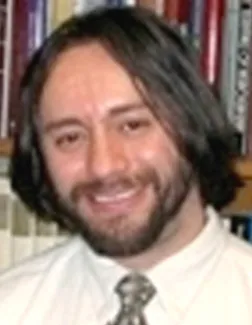

Information
Related Research Units
Research Overview
The goal of my research is to develop noninvasive imaging techniques for the quantitative evaluation of high-order cognitive processes of the brain, such as language, memory and visual-motor coordination. By carefully mapping these essential brain functions in healthy individuals, we seek to develop a framework from which to detect and quantify atypical functioning in patients with serious neurologic disorders including epilepsy, multiple sclerosis or tuberous sclerosis. Our approach combines multiple magnetic resonance (MRI) modalities to formulate a more comprehensive assessment of eloquent brain systems based on neural structure, white-matter diffusion and cortical functionality. To do this, we combine information derived from conventional MRI structural imaging, as well as from diffusion tensor imaging (DTI) and functional MRI (fMRI).
Functional activation of the language system
By developing novel, image-based biomarkers indicative of atypical neurocognitive function, my research aims to present unique information in the clinic that can be used to help preserve vital cognitive functions in pediatric patients suffering from serious brain diseases.
Research Background
Ralph Suarez holds degrees in physical anthropology, mathematics and physics. He completed an MSc in Medical Physics at the University of Wisconsin-Madison, where he subsequently obtained a PhD in Neuroimaging. Before joining the Computational Radiology Laboratory (CRL) at Boston Children's Hospital, Suarez was a postdoctoral research fellow at the National Center for Image-Guided Therapy (NCIGT), investigating functional brain mapping in pre-surgical planning and neuro-navigation applications.
Publications
- Comparison of fMRI language laterality with and without sedation in pediatric epilepsy. Neuroimage Clin. 2023; 38:103448. View Abstract
- Discrepant expressive language lateralization in children and adolescents with epilepsy. Ann Clin Transl Neurol. 2022 09; 9(9):1459-1464. View Abstract
- Comparison of seeding methods for visualization of the corticospinal tracts using single tensor tractography. Clin Neurol Neurosurg. 2015 Feb; 129:44-9. View Abstract
- Passive fMRI mapping of language function for pediatric epilepsy surgical planning: validation using Wada, ECS, and FMAER. Epilepsy Res. 2014 Dec; 108(10):1874-88. View Abstract
- Impaired language pathways in tuberous sclerosis complex patients with autism spectrum disorders. Cereb Cortex. 2013 Jul; 23(7):1526-32. View Abstract
- Automated delineation of white matter fiber tracts with a multiple region-of-interest approach. Neuroimage. 2012 Feb 15; 59(4):3690-700. View Abstract
- A combined fMRI and DTI examination of functional language lateralization and arcuate fasciculus structure: Effects of degree versus direction of hand preference. Brain Cogn. 2010 Jul; 73(2):85-92. View Abstract
- Threshold-independent functional MRI determination of language dominance: a validation study against clinical gold standards. Epilepsy Behav. 2009 Oct; 16(2):288-97. View Abstract
- Contributions to singing ability by the posterior portion of the superior temporal gyrus of the non-language-dominant hemisphere: first evidence from subdural cortical stimulation, Wada testing, and fMRI. Cortex. 2010 Mar; 46(3):343-53. View Abstract
- Comparison of blocked and event-related fMRI designs for pre-surgical language mapping. Neuroimage. 2009 Aug; 47 Suppl 2:T107-15. View Abstract
- A Surgical Planning Method for Functional MRI Assessment of Language Dominance: Influences from Threshold, Region-of-Interest, and Stimulus Mode. Brain Imaging and Behavior. 2008; 2(2):59-73. View Abstract
- Group independent component analysis of language fMRI from word generation tasks. Neuroimage. 2008 Sep 01; 42(3):1214-25. View Abstract
- Quantification of white matter fiber orientation at tumor margins with diffusion tensor invariant gradients. Proceedings of The International Society for Magnetic Resonance in Medicine Annual Meeting. 2008; 16(1). View Abstract
- Identification of essential language areas by combination of fMRI from different tasks using probabilistic independent component analysis. Journal of Biomedical Science and Engineering. 2008; 1(1):157-162. View Abstract
- Functional MRI of memory in the hippocampus: Laterality indices may be more meaningful if calculated from whole voxel distributions. Neuroimage. 2006 Aug 15; 32(2):592-602. View Abstract
- Automated Detection of White Matter Fiber Bundles. Proceedings of IEEE International Symposium on Biomedical Imaging (ISBI 2011), pages 845-848, 2011. View Abstract
- Automatic delineation of white matter fascicles by localization based upon anatomical spatial relationships. 10th IEEE International Symposium on Biomedical Imaging (ISBI), San Francisco, USA, 2013. View Abstract